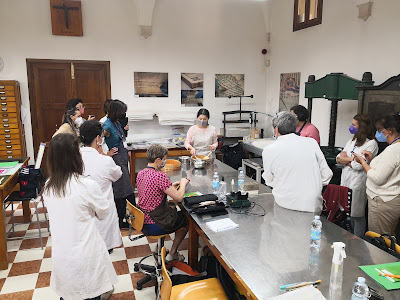In the magical frame of the Abbazia di Praglia, where it’s located the historical Laboratorio di Restauro del libro e di opere su carta, between September 7th-9th 2021 it took place the workshop “Asian Papers and their Applications in Paper Conservation”. It was run by Minah Song, a paper conservator with a great experience owned by years of personal practice and courses all over the world, and it was dedicated to paper conservators in order to learn more about materials of daily use, as Asian papers, and to experiment new methods and innovative uses of this kind of material.
The first
day began with a theoretical session about the origins of Asian papers between
China, Japan and Korea, focusing on the differences between these three
countries concerning raw materials and production. The evolution of papermaking
during the years to the present, make us know how the properties and the
quality of a sheet are influenced by different factors like soil, climate,
production process, materials used (as fillers, whiteners or formation aid) and
traditional local crafts: from the same fiber we can produce different paper.
This focus can help paper conservators to select different papers for different
uses and conservative aims. The lecture was also enriched by some explicative
videos and samples of different Asian papers.
The second
part of the day was dedicated to the creation of a drying board and to the
friction drying method.
- The drying board was made with
a honeycoomb panel covered by machine made Japanese paper (100% Japanese
kozo, 30 gsm) using wheat starch paste and later it was coated with an acrylic dispersion (Lascaux 498HV
in water). It can be used in the same way of Karibari drying
technique.
- The friction drying method was
related to the flattening of tracing paper, or a paper support with
irregular distortions, using mulberry paper as drying support instead of
hollytex, reemay or bondina, before with a provide of moisture (more or
less depending on the situation) and than a pressure under heavy weight.
The process can be repeated as many times as necessary, it assure a very
gentle flattening without any stress for paper.
The second
day provided the production of two kinds of handmade paper, one with mulberry
fiber and one with mixed fibers of antique paper. The Asian fibers were whiter
but also so much longer and stronger than the western fibers, that’s why it
needed a formation aid (in this case we used Polyacrylamide) to distribute the
fibers in the water, on the contrary, the antique paper fiber was already well
dispersed and didn’t need any additional material. Using an embroidery frame, we made some
little sample of both kinds of paper, learning that we could decide the
thickness of the sheet and also the texture of it, which could be very useful
in conservations for repairing losses or tears.
After the
papermaking, we talked about different methods for toning the paper and we
experienced them, using both brush and airbrush with acrylic colors, on some
pieces of Asian sheets which could be used for repairing losses on browned old
paper, with the possibility of layering more than one paper to reach the right
tone.
In the
afternoon we prepared pre-coated papers, useful in case we can’t apply too much
moisture on the paper support. The instructor selected three types of adhesive
considering different factors: «flexibility, viscosity, clarity, fast
hydration, wettability, visibility, stability and efficiency». Starting from
her personal experience, she choose
- 1,5% Klucel M in
ethanol (it doesn’t need water to activate)
- 6% Isinglass in water
(it need a very gentle addition of water to activate)
- 5% Aquazol 500 in water
(activated with heat).
So we
prepared three very thin pre-coated papers (less than 5 gsm because thicker
papers would require too much adhesive) and let them dry for the next day.
The last
day started with a theoretical session to resume what a paper conservator
should know before choosing and buy Asian paper, like raw materials, alkali
used during the production process, formation aid etc… because usually paper
vendors don’t give this kind of informations to their costumers even if these
are very important to the conservative aims.
Moreover,
in the afternoon we finally used the stuff we prepared the days before: we
experienced the traditional lining on the drying board we made the first day,
using Japanese kozo 15gsm as lining paper on a modern newspaper piece. We used
paste as glue and hollytex as support, and we basically followed the Karibari
drying method putting a strip of dry paper on one edge to make the removing
easier once the sheet will be dry. Before that, we repaired the losses and the
tears on the newspaper with the toning paper we made previously.
About
lining, the instructor suggested us a very easy method for lining both the two
sides of a sheet all alone and in “one shot”, using hollytex and very diluted
paste.
We also had
the possibility to use the hand-made papers we proudly made the day before for
fixing some losses of other modern damaged papers (all the samples were
generously provided by our instructor), in this case for tears we tried the
pre-coated paper and tested the three adhesive proposed by our instructor.
Unfortunately
the course lasted only for three days, but it has been very intensive (see how
many things we have done and talked about!) and interesting. A dutiful thanks
to our instructor Minah Song, a lovely and a very professional and prepared
person who let us see in a very new way some of the everyday use materials in
paper conservation as Asian papers.
Laura Riato - Paper Conservator



Nessun commento:
Posta un commento